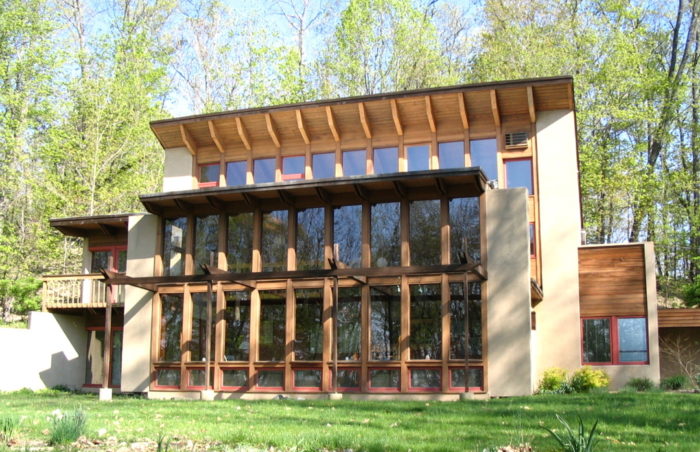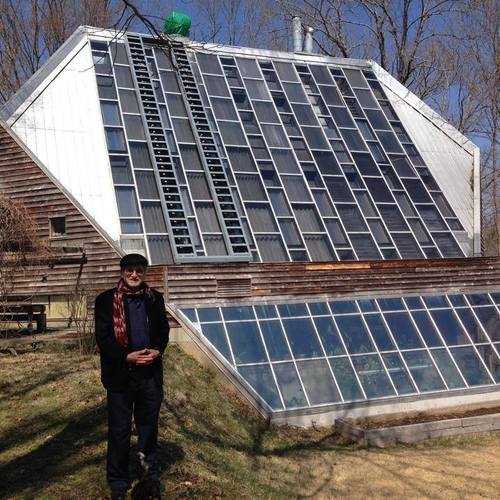Image Credit: Spector Associates
Recently a friend asked for help in designing an off-grid house. Interestingly, I pulled out the old books from the ’70s to show as examples and inspiration. We tagged a combination of ideas: an earth berm house, a passive solar house, an attached greenhouse buffer space, a solar thermal system, and a stack effect heating/cooling system incorporating a heat sink (southern rock exposure) and a cool northern forest glen.
It all seemed so — natural …
Apparently this approach differs greatly from the current focus on technology: low-e windows, photovoltaic panels, energy-saving bulbs, energy-efficient HVAC.
In the 1970s, many homes lacked central air conditioning
Why the difference? I’m going to give away my age here, but I think there might be a clue in the conditions experienced during our “growing up” years.
The energy-efficiency pioneers of the ’70s were raised in a world which was just starting to incorporate central forced air heating and central air conditioning in commercial buildings, but mostly without that buffer of mechanical temperature controls in their homes. They knew summers to be hot and winters to be bone-chilling cold. They experienced humidity, and knew the cooling effects of a light breeze.
So the “problem” they were solving was the core issue of achieving a more even temperature and humidity to increase the comfort level.
The catalyst which sparked the flurry of home innovation in the 1970s was the OPEC oil crisis, but the ’60s generation set the stage, with the interest to go “organic,” to embrace nature, and to do your own thing.
So the ’70s energy-efficient designs are innovative and organic; they leverage opportunities offered by natural elements. They are based on building physics, harnessing solar heat, moving air through buffering plenums, shading designs for cooling.
Mechanical heating and cooling systems were then positioned as supplemental, providing the final bit of temperature moderation. And “mechanical” solutions were equally creative in those days, including whole-house fans, solar thermal radiant heat, Trombe walls with fans…
These days, central air conditioning is considered a necessity
But forced air mechanical units essentially trumped all those approaches, and this Millennial Generation approaches design from a different reference point. They start with the presumption that central air HVAC is normal and necessary.
So then the question becomes: how should we produce the electricity to feed this mechanical creature which has a permanent spot in your basement or attic? So we put our efforts into solar panels, windmills, or hydroelectric systems.
And the HVAC monster is not the only electricity-gobbling resident in the household. There are water heaters, refrigerators, coffee makers, microwaves, TVs, radios, hair dryers, hair curlers, hair straighteners … and a gazillion more gadgets.
In systems-thinking jargon, we would call this an electricity addiction. And the interesting part is that if electricity prices are kept low (either through subsidized coal or subsidized PV panels), then it triggers an even greater addiction to electricity.
While I’m not necessarily advocating a return to the cave, this addiction (and new norm) distances the HVAC “solution” even further from the core issue, which is rooted in building physics.
From solar to Architecture 2030
So call me an old geezer looking for some recognition for my craft, or a die-hard granola, but I prefer to bill myself as a systems analyst and root-cause problem solver who thinks we could learn a lot by cruising the second-hand bookstores and picking up the old ’70s energy-efficiency solutions.
If the black and white photos make you uncomfortable, you can certainly Photoshop in some color — but I think there is some fundamental knowledge to be gained. And if you prefer to learn online, there is no finer collection of these experienced builders than here at GBA. These guys have been experimenting, building, and testing building systems for years. (For example, click here to read an excellent synopsis of the solar-versus-superinsulation lessons from the last 30 years).
Which brings me to Ed Mazria, who I first knew as the author of the landmark book on passive solar building. Now he is best known and the catalyst for the Architecture 2030 movement, bringing together good science, analysis, and problem solving to boldly set the energy bar at the level we need to see to address our climate issues.
Minimizing the need for space conditioning
So what if we were to design with the starting premise of no mechanical assist in dwellings? Afer we’ve refined the design as best possible, only then would we identify the need for supplemental space conditioning. The energy for this smaller and more targetted heating and cooling equipment can come from the grid, but ultimately, we would “pay” this forward by creating excess energy, cleaning more air than we pollute, harvesting and placing more water than we use.
This goal of becoming energy-neutral might help reassess the need for all the electrical gadgets as well. Combining the knowledge gained through the experimentation of the ’70s and ’80s, the growing knowledge of building science, and the technology of the Millennium, there is no reason we couldn’t achieve Mazria’s goals and leave our own legacy for our children to build upon.
Vera Novak writes the Eco Build Trends blog and is currently earning her PhD in Construction from Virginia Tech.
Weekly Newsletter
Get building science and energy efficiency advice, plus special offers, in your inbox.














6 Comments
Build an efficient envelope
Vera,
You hit all of the important points with the first, best choice being a super efficient building envelope. The 70's and 80's and the superinsulation movement that followed showed us the value in building airtight and using thick insulation. We now know a moderate amount of south facing glass is preferable to all glass. Windows have improved some but the cost per sf forces one to do the math before buying. Insulation has changed little over the years, keep it dry and it will perform.
We live in a world of gadgets and nobody profits unless there is chaos and the turn. Home improvement is where it's at today, a really well built home does not need much improvement.
evolution of building science
Those houses from the 70's were great experiments - The Germans took notice and continued to develop the ideas and came up with Passive House which is based on simplicity and quality. Unfortunately so many of the 70's houses failed on air quality, comfort and moisture problems. I have all those old books and grew up on Mother Earth News. The Passive House standard is pretty extreme (until you start doing the cost benefit analysis) but it is a great source of trickle down building science and I like how building science actually seems to going through a process of simplification now but is still based on all those 70's ideas and ideals . The gadgetry issue is a whole separate and big issue for sure.
brown green vs blue green
I was trained as an engineer long before I took interest in sustainability issues; so my second education, as a green thinker and designer, came largely from the permaculture and earth-building communities.
Coming from this background I see two very different design philosophies in play: what call brown-green (the earthbuilders, with their cob and strawbale) and blue-green (the technopihles with their heat pumps and windows and PV).
I've been working as an HVAC designer and commissioning agent, mostly in large institutional and commercial buildings, and during that time I have tried to bring some of the brown-green thinking - if not their materials - to the blue-green camp. It has been very slow going.
One factor at play here is the commercial/profit potential associated with blue-green design. Blue-green is technophilic, and thus tends to be attracted to gadgets and widgets and things that must be manufactured and sold and paid for. In comparison, the brown-greens, in many cases, operate in large part outside of the cash economy. Their materials are those which can be found on-site and/or gathered for free. Thus there are very few opportunities for an investor to earn outsized profits from the brown-green world.
Is it any surprise that blue-green thinking completely dominates the industry?
Good points
It is interesting to consider that less than 50 years ago many homes had no central AC, and many didn't even have central heat, relying on space heaters and floor furnaces. We have indeed, become a weak and soft society, most people unwilling and believing they are incapable of surviving without central HVAC. I wonder if, as a society, we will be able to unlearn this behavior and retrain people to not only create buildings that respond appropriately to the environment, but also use those buildings efficiently. Far too often, people run HVAC during beautiful weather rather than open windows and doors because it is easy, and for many people, energy costs are low enough that the financial pain just isn't there. When energy costs rise enough, we will start to see people living in the environment instead of hiding from it in their super insulated buildings with high performance HVAC, although I dont expect to see it any time soon.
Super Solar Houses by William A. Shurcliff 1983
I just reread Super Solar houses by William A. Shurcliff published in 1983, after seeing this blog. Does anyone know how the Cliff House featured in this book turned out? The data in the book was very impressive and the house was a nice clean design. The book was published before the owners occupied the home.
Brown/blue green or something in between
Brent - I loved your categories of brown/green and blue/green. But then I found myself lingering between camps. Maybe due to my background in ICFs. I'm totally good with the "technology" of EPS foam, but opt for the Passiv House approach to reducing the reliance on mechanicals. There again, I'm o.k. with mechanicals - albeit with a preference for simple systems with fewest electronics. Does this make me a granola techie? Is there a color between brown and blue? Thanks for you insights
Log in or create an account to post a comment.
Sign up Log in